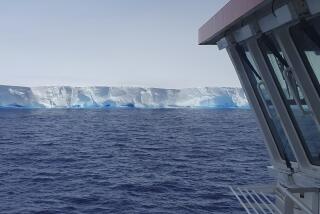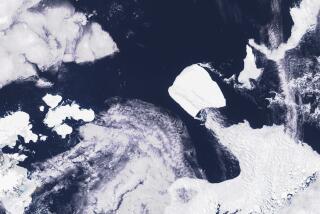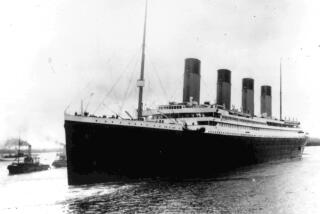Titanic today might dodge better but would encounter more icebergs
- Share via
The Titanic hit an iceberg off the coast of Newfoundland, but it probably didn’t hit one the size of Manhattan.
As oceans warm and global ambient temperatures rise, glaciers in Greenland and ice sheets in the Antarctic are calving bigger and more numerous icebergs. One the size of Manhattan floated free from Greenland in 2010, as seen in this video.
April 15 marks the 100th anniversary of the sinking of the Titanic, which sank after hitting an iceberg on its maiden voyage in 1912. Ships are less likely to hit an iceberg today than they were then – thanks mostly to radar – but as we move into a season of remembrance with the 3D re-release of the global blockbuster film “Titanic” and a number of other commemorative events, it’s important to realize that climate change has made the problem of icebergs clogging sea lanes worse, not better.
Frank Lowenstein, climate adaption strategy leader at the Nature Conservancy, wrote a blog post on the topic last week.
“The Titanic has long been a topic of interest for me. I was working at Woods Hole [Oceanographic Institute] in 1985 when the wreck was found, was an editor at Oceanus magazine, and we put out a whole special issue dedicated to the Titanic,” Lowenstein said.
Curious about the iceberg situation today, he started researching and found himself looking at an Antarctic iceberg the size of Rhode Island, which was broken off when the Mertz Ice Tongue was bumped by another iceberg the size of Luxembourg. “These icebergs are big and there are more of them,” he said.
One of the probable reasons the Titanic hit an iceberg in 1912, Lowenstein says, is that the winter was exceptionally mild and the Greenland glaciers calved off more ice than normal. But it’s nothing compared to today.
“Antarctica and Greenland are losing somewhere between 100 and 200 gigatons of ice each year,” Lowenstein says. “A gigaton is basically an ice cube that’s a kilometer on a side. About half of it is actually just melting and coming off as water, and the other half is coming off as icebergs.”
Halting iceberg calving is a tall order, but there are things people can do right now to combat the effects of melt-created ocean rise and the increase in adverse weather events.
Lowenstein, who coordinates the Nature Conservancy’s response to climate change, says: “We need to take steps to make our society more resilient. Like restoring flood plains to make ourselves less vulnerable along rivers. On the Gulf of Mexico, we’re working to restore miles of oyster reef off the coast of Alabama. It breaks the waves and reduces erosion along the beach, and helps us be less vulnerable to storm surge. So there are ways that nature can help us adapt and to be ready.”
RELATED:
Judge orders testing of evidence in Judi Bari bombing
GM pulls support for Heartland Institute
Hunters, anglers report warming winters bad for wildlife






